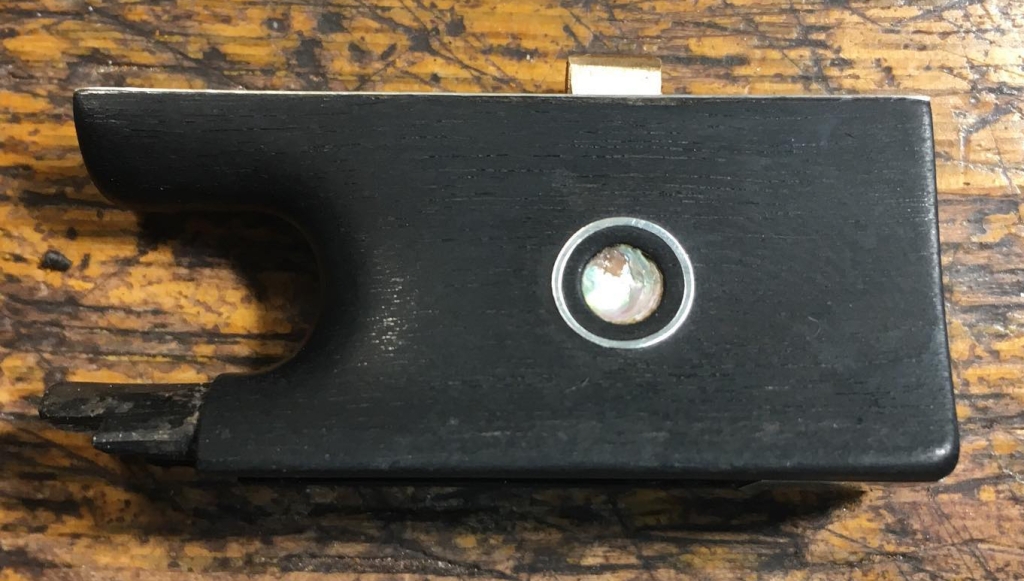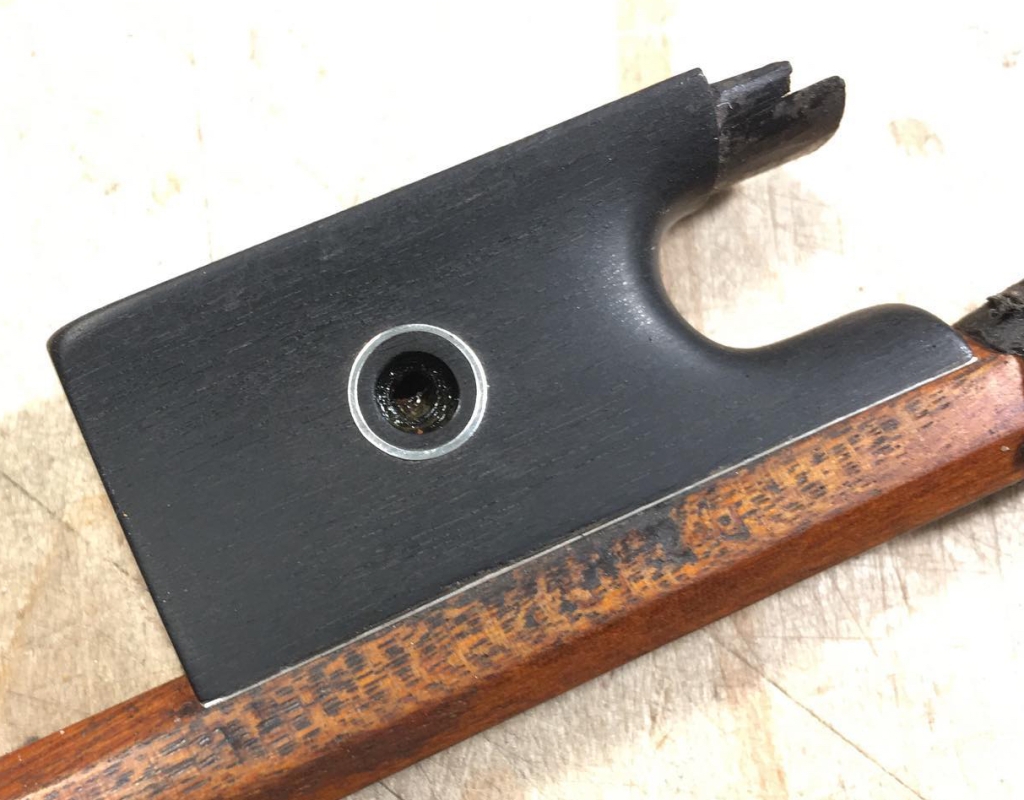This beautiful E. Sartory violin bow was in the shop for a pearl eye replacement. When working with a bow of some age, special attention is needed to ensure an original appearance.
Removing the Old Pearl
Before a new eye can be fit, the old worn and degraded pearl must be removed.

As it was likely that this eye was glued in with Hide Glue, and a drop or two of hot water will loosen the eye. Much of the old pearl worked free or crumbled and came right out. Great care was taken to not oversaturate the area with water as to prevent the silver ring from working itself out.
The recess was further cleaned out with Dental Tools and the surfaces prepared to accept the new pearl eye.

Abalone shell was selected to match the opposite eye and pearl slide.
The pearl is oriented in a such a way that it is most iridescent when the frog is viewed from the side with the pearl slide facing down. This is how most people will view the frog on bows.
The perimeter of the pearl is filed to fit the recess perfectly. One drop of Cyanoacrylate Glue is placed in the recess and the eye is set in place. Once the cyanoacrylate fully cures, the cheeks of the frog are protected with electrical tape and the excess pearl is removed with a half-round Needle File
.
Because the ebony has worn a little, the silver ring sits slightly proud and great care is taken to not touch it or the ebony with files. The thickness of the tape ensures that the pearl is still a little thicker and keeps the files from getting too close to the silver ring.
Final Shaping
The final shaping is carefully done with acid and a cotton swab. The edges of the pearl are brought exactly to the ebony while a little dishing in the center is necessary so that the eye appears to have very light wear. This is important on a bow like this since the rest of the pearl on the bow shows light wear. The acid gives a nice patina to the pearl and no additional polishing of the eye is needed.
I really like to polish the frog with a little Renaissance Wax to protect the wood, silver, and pearl which also brightens up the finish without changing the original patina.
The Final Result
The end results leave an appropriately full pearl eye with a nice patina that matches the light wear to this fine old bow. Additionally, the side of the frog is never touched with any abrasives so that the natural patina of the ebony matches the rest of the frog.






A few observations. French makers seldom used ‘flash’ pearl at this period, preferring to let the workmanship and the playing qualities speak for the skill of the bow maker. For instance, Sartory was very clever in using white pearl for his slides but so thin that the backing ebony ‘grinned through’ giving the pearl a blue depth effect. If the pearl on this bow was like the replacement eye, I suggest the bow is a copy, and not that old either. The replacement was ‘filed to fit perfectly’? Grinding is much easier (and you end up with a circle), and beware the dust as it’s carcinogenic. How about using the same glue as the original to fit the replacement? Then the next person to do the same job won’t have a fight on their hands removing cyano and causing unnecessary damage to the recess. And there’s not much need to attack the pearl with acid – the player(s) will do a perfectly satisfactory job of that over the years!
Andrew Bellis, U.K.
Thanks for sharing your thoughts. The bow is definitely a real Sartory and heavily supported with a clean certificate. While the original pearl may have been something other than what’s currently in the frog, perhaps later replaced by someone else, it wouldn’t be worth replacing all the pearl since the condition of the other eye and slide are an fairly good condition. Don’t you think it would be better to match the rest of the pearl? Grinding is fine, I mostly do that with new my new bows, but because these holes are worn and are rarely perfectly round, it has been proven that the imperceptibly out of round looks better. CA is now the accepted standard and is easy to remove with a drop of acetone, I’ve never had a hard time removing pearl when I can identify the proper glue. The acid creates a nice patina so that the eye doesn’t appear brand new right off the bat. This is really important if one is preparing a bow for sale, just like it would be smart to lightly tarnish a ferrule replacement. Thank you for commenting on a number of my posts, I enjoy your view points and the discussion!
I’m sure the bow is seen as genuine, but like Hill bows, the workmanship is so predicable and ‘straight’ that it’s easily copied, both in Europe and abroad. And it pays to remember that Sartory sub-contracted his frogs and buttons anyway. Also the old joke that “It is believed that Eugene Sartory made 2,500 bows in his lifetime, and 5000 of those are in America” though there’s a loud ring of truth in that. Imitation is the sincerest form of flattery!
Out-of-round eyes (and surely you mean ‘barely perceptible’ – ‘imperceptible’ would be pointless…) work on their own, but if surrounded by a perfect ring, look awful, like bad workmanship. The presence of a ring and eye inlay implies workshop facilities that can produce such extra skill on top of fine stick making, and ‘perfect’ round eyes go along with that. Nobody criticises Hill’s inlay work (or they had better not, anyway!). Hills used ‘Seccotine’ glue for theirs, a cold use fish-based glue no longer obtainable that stank to high heaven. Nearest equivalent nowadays is Franklin’s liquid hide glue, and that’s what I use. No need for these modern ‘wonders’!